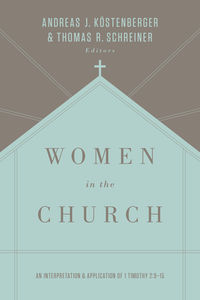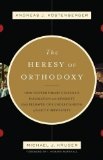Das Buch Frauen in der Gemeinde ist in einer 3. Auflage erschienen als:
- Andreas J. Köstenberger u. Thomas R. Schreiner (Hg.), Women in the Church: An Interpretation and Application of 1 Timothy 2:9–15, 3. Aufl., Wheaton, IL: Crossway, 2016.
Was ist neu? In der Einleitung steht:

Initially, we planned simply to update each of the chapters in the second edition and to replace the single-author chapter on application with a virtual roundtable in order to express the diversity of ways Christians apply the teaching of 1 Timothy 2:9–15.
Then, developments ensued in rapid fashion. First off, Henry Scott Baldwin gently but firmly declined revising his chapter, suggesting that Al Wolters, who has engaged in cutting-edge research on the term αὐθεντεῖν for the past decade, be pressed into service. After initial hesitation due to other commitments, Al kindly agreed to write for the current volume what we are convinced is now the definitive essay on αὐθεντεῖν. While building on Baldwin’s work, Al powerfully sharpens his argument and engages all the recent scholarship on the meaning of αὐθεντεῖν judiciously and compellingly. The inclusion of Al’s chapter alone warrants the production of this third edition.
Also, one by one, the other contributors decided against giving their chapters a mere “face lift” and opted instead to write a fresh piece that is congruent with their work in earlier editions but presents the material in light of developments in the past two decades and in keeping with current research and cultural dynamics. S. M. Baugh and Robert Yarbrough, in particular, spent a considerable amount of time, with much careful thought, presenting the background of 1 Timothy 2:9–15 to apply it to our cultural context in a fresh, new light that is sure to connect both with readers of previous editions and with those new to the debate.
I, too, decided not merely to touch up my chapter but to completely rerun all my searches of the Thesaurus Linguae Graecae (TLG) database in an effort to isolate the most pertinent syntactical parallels for the grammatical construction found in 1 Timothy 2:12. More detailed search parameters and a more robust database now available have allowed me to narrow my investigation from its previous four-century span to include only authors who wrote in the first century AD, while simultaneously adding thirty-one examples. I also decided to integrate my interaction with the scholarly literature on the subject throughout my essay rather than collecting responses at the end as in the second edition.
Finally, we asked Denny Burk to write a brand-new chapter on Bible translation. This addition seemed necessary since the NIV 2011 translation committee retranslated αὐθεντεῖν in a rendering that went against the NIV 1984 and even the TNIV 2002.
Die ersten 28 Seiten können hier heruntergeladen werden: women-in-the-church-excerpt.pdf. Außerdem gibt es ein Interview mit Köstenberger: www.crossway.org.

 Andreas Kostenberger, der
Andreas Kostenberger, der  Kevin de Young hat mit dem hervorragenden Exegeten Andreas Kostenberger über sein Buch
Kevin de Young hat mit dem hervorragenden Exegeten Andreas Kostenberger über sein Buch